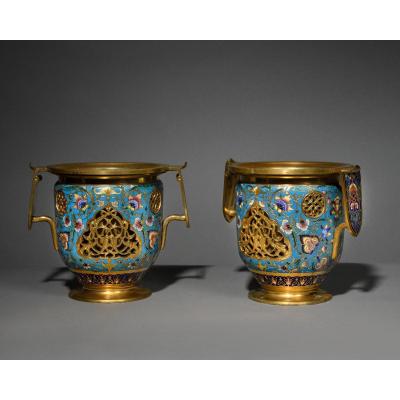Patinated bronze.
Naples.
End of the 19th century.
h. 47,6 in. ; d. 15,7 in. ; w. 21,25 in.
A patinated bronze tripod, 19th century replica of a famous brazier discovered in the villa of Julia Felix in Pompeii. This tripod (named Athénienne in French due to a 1770s trend amont the French elites) is in fact a brazier, or clibanus, the type of which the Romans, in their domus, used to heat the rooms of their choices in winter.
The original tripod, exhibited in the Gabinetto segreto of the National Archaeological Museum of Naples, is made out of three young ‘ityphallic’ satyrs ‘whose legs are joint and end in a goat's foot’. It was discovered on 15 June 1755 in the Praedia of Julia Felix, a wealthy though mysterious heiress in Pompeii. It was depicted and commented on in the third volume, published in 1759, of the Recueil d'antiquités by the Earl of Caylus, an illustrious French collector and archaeologist.
The tripod is a work from the Fonderia artistica Chiurazzi, founded in Naples in 1840 by Gennaro Chiurazzi, only artist allowed to make casts out of the antiquities of the Archaeological Museum of Naples. When, in 1974, the J. Paul Getty Museum decided to acquire a collection marbles and bronzes from Campania, Chiurazzi’s artistic replicas seemed to have been an easy choice.
The Fonderia Chiurazzi, most likely for reasons of politeness and convention, tried to tone down the erotic character of the ‘ityphallic’ original. Other did so in the past, as the engraver Henry Moses, Giambattista Piranesi and the Earl of Caylüs himself, and Chiurazzi seems to have followed the drawing of Henry Moses.
The Chiurazzi version of the tripod is a rare edition, embellished with an important 12 in. bronze pedestal that can be removed easily.
Sources
Anne-Claude de Pestels, Earl of Caylus, Recueil d'Antiquités égyptiennes, étrusques, grecques, romaines et gauloises, t. III, Paris, 1759.
Émile Dacier, « L'Athénienne et son inventeur », dans Gazette des Beaux-Arts, t. VIII, n° 835, Paris, juillet 1932.
René Ginouvès, Dictionnaire méthodique de l’architecture grecque et romaine, t. II, Rome, 1992.




































 Le Magazine de PROANTIC
Le Magazine de PROANTIC TRÉSORS Magazine
TRÉSORS Magazine Rivista Artiquariato
Rivista Artiquariato